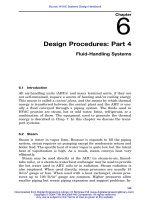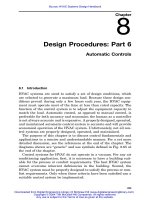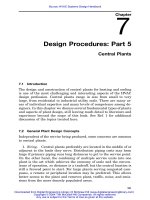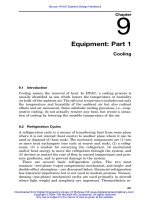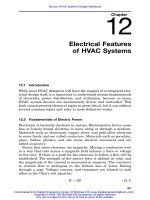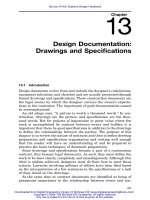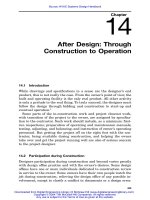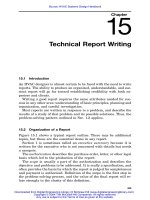Ebook Basics design 08 - Design thinking: Part 2
Bạn đang xem bản rút gọn của tài liệu. Xem và tải ngay bản đầy đủ của tài liệu tại đây (9.38 MB, 104 trang )
Personification
Personification
A design often personifies the particular
aims, attributes or characteristics of a
company, product or programme into
a recognisable graphic device.
Personification is an abstract quality that is used to represent the highlighted
characteristics of a company or brand. Designers create graphic devices that
personify these qualities so that consumers or customers can form an emotional
identification. Many company or brand logos function in this way.
For personification to be successful and credible, the graphic device – and the
attributes it represents – needs to successfully resonate with the target audience
and be compatible with the characteristics of the product or organisation. If not,
it will appear incongruous.
Design Thinking Refinement
To achieve this requires the use of both top-down and bottom-up approaches
to design: top-down in that the characteristics that will be personified must be
identified and prioritised and bottom-up in that visual ideas are generated and
conceptualised in consideration of what will appeal to the target audience.
Heal’s (facing page)
Pictured is a packaging range created by Pentagram for furniture and home products
manufacturer, Heal’s. The monotone, imageless design personifies the company’s
simple, clean style, and uses a subtle, dry humour approach to design. Typograms
are used as graphic elements to form the stem of a glass, the handle of a fork and
the flame of a candle.
Typogram
The deliberate use of typography to express an idea visually and through more than just the letters that
constitute the word.
98 99
Client: Heal’s
Design: Pentagram
Design thinking: Typograms
add humour to personify
Design Thinking Personification
contemporary design style
Visual metaphors
Visual metaphors
A visual metaphor refers to something it
typically does not denote in order to imply
a similarity to something else.
This new meaning implied by a visual metaphor is often created by the context in
which the visual device is present. As such, for a visual metaphor to work (for the
viewer to perceive a specific meaning, in other words) requires the presence of
shared knowledge or culture. The existence of a common pool of shared
knowledge allows the designer to place subjective clues or references within the
overall design and this can form the basis of the metaphor.
The logo for Five Towns Make a
City features overlapping circles
that provide a visual metaphor for
Design Thinking Refinement
unification.
Medway Renaissance (above and facing page)
Pictured is a large-format book commissioned by Medway Renaissance in
England to convey the ideas of Sir Terry Farrell, lead architect and masterplanner
of a project tasked with uniting the five Medway towns (Rochester, Chatham,
Gillingham, Rainham and Strood). The logo is a visual metaphor for the five
towns and their area of influence and the distillation of their separate identities
into a single unit. The book was created with five different covers, featuring
portrait photography by Xavier Young of people from the five communities. These
photographs form metaphors for the towns they represent; the locations in which
they were photographed are instantly recognisable to the people from the region.
100 101
Client: Medway Renaissance
Design: Gavin Ambrose/Urbik
Design thinking: Visual
metaphor for unifying five
Design Thinking Visual metaphors
towns into a single ‘unit’
Modification
Modification
Designs often tell a story in a frozen
graphic instant. Modification is a key
design aspect that transforms text
and images in a way that instills them
with meaning.
Intervention
By intervening in an image a design can modify its meaning, stress or
significance, or change its focus entirely.
Omission
An omission is when something has been left out or forgotten. This can be
used to channel the viewer’s focus to the omitted element, or draw attention
to the context within which the omission occurred.
Opposition
When two or more ideas compete, conflict or resist each other, opposition
occurs. In graphic design, opposition is a form of juxtaposition whereby
elements are positioned to create an antagonistic relationship between
them due to their inherent contrasts – a devil image next to an angel image
to represent good and evil, for example. Effective opposition relies on
recognisable cultural or societal norms.
Design Thinking Refinement
Two-in-ones
Graphic devices can communicate two messages at the same time within
the context established by the design. This can be achieved by making
subtle variations to easily recognisable objects. Their success depends upon
the viewer’s ability to recognise and interpret the contextual references,
which means two-in-ones can be created to resonate with very specific
target audiences.
102 103
Client: Human
Design: Social UK
Design thinking: Modified
typography to instill
Human
Pictured is a business card, created as part of an identity redesign for music and
sound design firm Human, featuring modified typography. An intervention in the
counter of the lowercase ‘a’ has modified it into a sperm shape, whose tail
bisects the vertical stroke of the subsequent letter. This sperm character placed
in the word ‘human’ makes a direct reference to the start of every human life and
implies that the company has a very human approach to creating sound
solutions for its clients.
Design Thinking Modification
human characteristics
Design Thinking Refinement
Modification
Worx
Pictured is a series of advertisements created for office space design company
and architectural studio Worx. Each poster features a particular piece of furniture
created by leading Italian manufacturers. The posters use omission of other office
paraphernalia to highlight the important role of furniture in our lives. The art
direction in this campaign has resulted in highly stylised images that are as slick
as those one would expect to see in a fashion campaign.
104 105
Client: Worx
Design: Futro
Design thinking: Omission of
vital pieces of furniture in the
office environment highlights
Design Thinking Modification
the very importance of it
Modification
Client: Ninety Hairdressing
Design: Mark Studio
Design thinking: Two-in-one
visual device refers to the
service offered and the
Design Thinking Refinement
company name
106 107
Client: Magdalena 2004
Design: Miha Artnak
Design thinking: Simple
imagery for understated,
arresting impact
Ninety Hairdressing (facing page)
This design by Mark Studio for Ninety Hairdressing features a two-in-one visual
device. The image depicts the eye rings of a pair of hairdressing scissors, making
an obvious visual reference to the business of the client. The eye rings and the finger
guide also present a visual representation of the name of the company, Ninety.
Design Thinking Modification
Tanks a Lot
This poster was created by Slovenian designer Miha Artnak, a finalist at the
Magdalena International Festival of Creative Communication 2004. The simple
image features the colours of the Iraq flag bleeding and dripping on to the
ground, an understated yet arresting commentary on the death, destruction
and waste that the US-led invasion of Iraq has produced.
Thinking in words
Thinking in words
Words can be used in many ways to
communicate a message: they can help to
make it easily understood or can provide
a number of different possible meanings.
Designers need to think of words as words but also as visual design elements in
their own right, as can be seen in the examples below.
Some words are inherently more interesting than others
From a design point of view, some words are more interesting than others
because of the shapes they make on the page, but the inherent meanings words
have make some more powerful and arresting than others. For example, ‘death’
in the example below is arguably more interesting than the word ‘bread’.
DEATH
BREAD
Some typefaces are more interesting than others
As we will see later in this chapter, the typeface in which a word is set
communicates as much as the word itself. Different typefaces have different
‘personalities’ and convey different meanings accordingly. A typeface can
imply classical, futuristic, elegant or streetwise qualities, for example.
Design Thinking Refinement
ELEGANT
STREET
And let’s not forget, some typefaces are clearer than others
Clarity and legibility are important aspects of text communication. They refer to
the ease with which a person can read a message, in terms of the flow of the
component words, how the design aids or detracts from the ability to read it,
and the ease of reading a particular typeface.
CLEAR?
CLEARER?
108 109
Client: Urbik
Design: Gavin Ambrose
Design thinking: Creation of a
new word (neologism) and use
of a ligature helps to reinforce
the futuristic ‘personality’ of
the brand
Neologism
A new word, expression or usage, or one devised relatively recently.
Ligature
Two or more letters that combine to form one character. Ligatures are formed to represent specific sounds or
words, such as the Æ diphthong ligature, or to improve the visual appearance of certain letter combinations
such as the fl and fi combinations.
Design Thinking Thinking in words
Urbik
Pictured here is a brand identity for Urbik, a brand name devised and intended
to suggest, in a memorable way, the company’s interest in ideas about the way
people might live in the future. This new word ‘Urbik’ features two distinct
phonemes: ‘Ur’, a coastal city near the mouth of the ancient Euphrates River
(now Tell el-Mukayyar in Iraq), believed by many to be one of the first cradles of
civilisation; and ‘bik’, taken from Philip K Dick’s 1969 novel Ubik about a magical
ubiquitous substance and the struggle to find it. Dick’s other novels also raise
the issue of how we want our habitats to be in terms of architecture, urban
design and town planning. Note the ligature of the first two letters, reinforcing
the Ur phoneme.
Words and language
Words and language
Messages are communicated not just
through simple semantics. Our choice
of words and language and the tone
with which we deliver them all offer
deeper meaning to what we are saying.
Finding a ‘voice’
A message can be expressed in many different ways or with a different tone of
voice; for example, with authority, with contrition or with optimism. At times we
like to feel that someone is in control but at other times we do not like to be told
what to do. Finding the right voice is important in order to relate to the target
group and not alienate them.
Working with words
The raw material that words represent can be moulded and shaped in many
ways and to many ends. The creative use of language can help precisely
position an idea, company or product in the minds of the target audience.
The last 50 years have seen a growing acceptance in the media of more relaxed
language, with increasing grammatical flexibility and the use of regional dialects,
accents and slang. Rephrasing a piece of text into another voice can be done by
visualising the kind of person you think would communicate in the required way.
Design Thinking Refinement
Designers can use synonyms or other related words to move from a formal
approach to a more relaxed and tailored one that suits the target audience.
This can be done through the use of a table, such as the one shown below,
to direct the thought process in the desired direction.
Formal
Company brochure
Education buildings
Residential developments
Masterplanning
Offices
Reduction
Us
Kids
People
Space
Action
Informal
Our approach
Learn
Live
Place
Work
110 111
Client: Cartwight Pickard
Architects
Design: Gavin Ambrose/Urbik
Design thinking: Words
selected with reduction
Cartwright Pickard Architects
These five brochures, one a practice brochure, and the other four each looking
at a different sector of activity, form part of a set that introduces Cartwright
Pickard Architects as a leading architectural practice. Each brochure cover
features a single word, selected to reflect the human aim of architecture rather
than the specific disciplines that it comprises. For example, this saw the word
‘masterplanning’ become ‘place’, and ‘residential developments’ become ‘live’.
The table on the facing page shows the reduction processes that took place to
develop the titles.
Design Thinking Words and language
method reflect human values
Words and language
Visual patterns
Letterforms and words have visual patterns created by the typeface, size and
case. The visual patterns of letterforms are particularly important when it comes
to the design of logotypes and the creation of brands. Notice how the ascenders
and descenders alter the topography, or visual landscape, of the words below.
cope
lap
till
Cope has similar shaped
Lap’s ascender and descender
Till appears very upright and
circular letterforms – this could
stretch it vertically.
straight.
be used to the designer’s
advantage.
Vocal patterns
The vocal patterns or phonetic sounds and rhythms that words produce when
spoken can be replicated to some extent in graphic design. Some words, such
as boom, are onomatopoeic; they echo the sound of the thing they describe.
Other words have different vocal patterns: bar rolls off the tongue while back
has a harsh and abrupt ending.
boom
bar
back
A word with onomatopoeia,
A word ending with an uplift
A word that ends abruptly
which also looks like the noise
and a trilled ‘r’ sound that rolls
with a clipped ‘k’ sound,
it makes.
off the tongue.
which can be given a
Design Thinking Refinement
more aggressive delivery.
Onomatopoeia
The formation of words that echo the sound of the thing they denote.
Suffix
A word or stem ending that forms a new word or inflectional ending.
112 113
Client: Betster
Design: Studio AS/
Gavin Ambrose
Design thinking: Inventing
a new word for a brand-
Betster
Selecting a brand name that strikes a chord with the target audience can be
difficult. For this client, many names were considered initially. These were then
reduced via a process of elimination to Betster. Betster is a fabricated word or
neologism, formed using the word ‘bet’ and a user-friendly suffix. The suffix was
chosen as it is one that people are familiar with. For example, performance car
manufacturer Porsche makes a Boxster car and a betting pundit is a tipster. In
this way, the neologism ‘betster’ sounds as though it is a real word. Having a
unique word as a brand name has certain advantages, particularly when it comes
to registering a URL for a web address and the ability to take ownership of a
particular phrase or word.
Design Thinking Words and language
naming exercise
Words and language
Puns
A pun is a joke that exploits the different possible meanings of a word or image
or the fact that a word or image has different possible meanings.
The pun essentially substitutes one meaning for another within a context, to
give an alternative meaning. For a pun to be effective, a certain level of shared
knowledge or culture is required in order for the viewer to recognise the
alternative meaning. If not, it will appear incongruous and may even look like
an error. Polymath author and journalist Arthur Koestler defined a pun as ‘two
strings of thought tied together by an acoustic knot’, or in the case of a visual
pun, a visual knot.
The word pun
A play on words using alternative meanings of words and word sounds to form
new meanings.
The visual pun
A play on words substituting images for words to form new meanings.
Design Thinking Refinement
The rebus
Using images to form words based on the nouns they commonly represent.
The word pun
The visual pun
The rebus
This logo designed by Wolff
This visual pun is Milton
This IBM poster by Paul Rand
Olins features a word pun
Glaser’s classic mark that
features a rebus; images that
whereby ‘Q8’ represents the
substitutes a heart symbol for
represent the letters of the
oil-rich country, Kuwait.
the word ‘love’.
company’s name.
114 115
Client: Salomon
Design: Studio Output
Design thinking: A word pun
is used to link a company with
the familiar saying, ‘blood,
Salomon
This design was created for the bicycle manufacturer Salomon. It features a pun
on the phrase ‘blood, sweat and tears’, which becomes ‘mud sweat and gear’.
The t-shirt links the core business of the company – making mountain bikes –
to the familiar saying.
Design Thinking Words and language
sweat and tears’
Words and language
Client: Elk & Wolf
Design: Social Design
Design thinking: Text, imagery
and colour palette conveys a
Design Thinking Refinement
sense of style
116 117
Client: Oliver Spencer
Design: Marque
Design thinking: Geographic
coordinates add an eccentric
Oliver Spencer
Pictured is a stationery design that features the geographic coordinates for London –
51.52N,0.12W. This code adds an eccentric element to the stationery, referencing
fashion designer Oliver Spencer’s eclectic collections, travel and sense of adventure.
Elk & Wolf (facing page)
The design of this wine bottle label uses text, imagery and a colour palette
to convey a sense of style and coolness. The brand text and image both express
the same idea, visually and verbally. Note how they reflect one another through
the design treatment given: the animal images are presented as a black
silhouette, as is the text, and an elaborate ampersand character in the text
is a facsimile of the elk’s antlers.
Design Thinking Words and language
element to a simple design
Type ‘faces’
Type ‘faces’
Typefaces have their own personalities and
so it is appropriate to note the different
faces or characters they have.
The different roles or functions that type serves within design means that
designers need to think about which type personality is appropriate for the
message to be communicated. The face that type is set with can help or hinder
information transfer, as each face tells a different story, and provokes different
feelings within the viewer.
At a basic level, type allows detailed information to be communicated to the
viewer. Secondly, as type is a series of marks on a page, it can also be used for
a more graphical purpose; the way those marks are formed creates different
shapes and use of the space on a page.
Different typefaces have different personalities to the extent that they can be
said to actually have ‘faces’ that tell stories and convey feelings other than the
words they present. Some typefaces appear serious, some are upright and
conservative, while others are fun, adventurous and youthful, for example.
Design Thinking Refinement
Type
Type
Type
Bodoni Poster
DIN
Desdemona
A modernist serif typeface with
A functional and efficient
This art nouveau type has a
a young and sturdy feel.
sans serif typeface with a
romantic, spiritual feel that
neutral, passive feel.
harks back to a chivalrous age.
Type
Type
Type
Cirkulus
Courier
Brush Script
A modernist sans serif typeface
A cold, mechanical
A fun and animated script
with a playful, chaotic feel.
serif typeface with a
typeface that conveys a feeling
bureaucratic feel.
of youthful energy.
118 119
Client: The Powerscourt
Centre
Design: Unthink
Design thinking: Text
elements set as gifts to give a
The Powerscourt Centre
This poster for The Powerscourt Centre advertises a series of festivals in December.
The organisation’s name is set in display type with each character appearing to be
wrapped up like a present, complete with ribbons and bows. This reflects the fact
that the various events are being presented as part of the festive season.
Design Thinking Type ‘faces’
festive feel to the design
Thinking in shapes
Thinking in shapes
Design elements such as text blocks form
approximate shapes on a page. Thinking in
shapes helps the designer to address general
spatial relationships between the elements.
Thinking in shapes considers the spatial relationships that exist between different
design elements and how they fill a page. Various effects can be achieved by
thinking of page elements in this way. In 1923, Wassily Kandinsky proposed a
universal relationship between the three basic shapes and the three primary
colours. He believed the yellow triangle to be the most active and dynamic and
the cold and passive blue circle to be the least so.
Harmony
Harmony is an agreement in feeling between the different elements of a design.
This can be to such an extent that they support one another to produce an
effective and coherent visual statement. Harmony can be achieved on different
levels within a design, such as typographic selections that complement each
other, colour schemes that are sympathetic and do not clash, and images that
communicate the required message well. These varied design elements can
harmonise with each other and the entire design can harmonise with what it was
created to represent, whether this be a company, product, service or institution.
Harmony is pleasing to the eye and is an indicator of good design. As such,
it often goes unnoticed, as pointed out in the axiom, ‘good design is never
recognised, only bad design’.
Design Thinking Refinement
Balance
Balance is a state of equilibrium in which no single part has a greater weight or
presence than another, producing a soothing, peaceful and non-dramatic result.
In graphic design one talks of visual balance achieved through the considered
positioning of page elements; an even interaction of text, images and white
space. In this context, each element can be thought of as a shape that needs
to be positioned in harmony with the other shapes within the design.
120 121
Dynamic shapes
Wassily Kandinsky believed the
yellow triangle to be an active
and dynamic form and the blue
circle to be cold and passive.
Shape alliteration
Similar shapes can be grouped together to create larger elements. This will help
to balance out a page, especially if other large shapes are used in the design.
Drama
The use of more dynamic, angular shapes, such as Kandinsky’s triangle, can
add drama and interest to a design due to the presence of more acute angles.
Each line of text set in a triangular block, for example, would have a different
length and would contrast starkly with that set in a typical rectangular block.
Using shapes in design
At a macro level, a design can be infused with different shapes to produce
different tensions on the page – different active and passive areas. This will
lead the eye to different areas of a layout, and will alter the positive and
negative space.
Symmetrical
Asymmetrical
A symmetrical spread sees the folio structure
An asymmetrical spread sees the folio structure
mirror itself to produce a balanced layout.
repeat to produce a layout weighted to one side.
This is more dynamic than a symmetrical layout.
Design Thinking Thinking in shapes
Layouts can also be either symmetrical or asymmetrical. This too will influence
shape placement.
Design Thinking Refinement
Thinking in shapes
